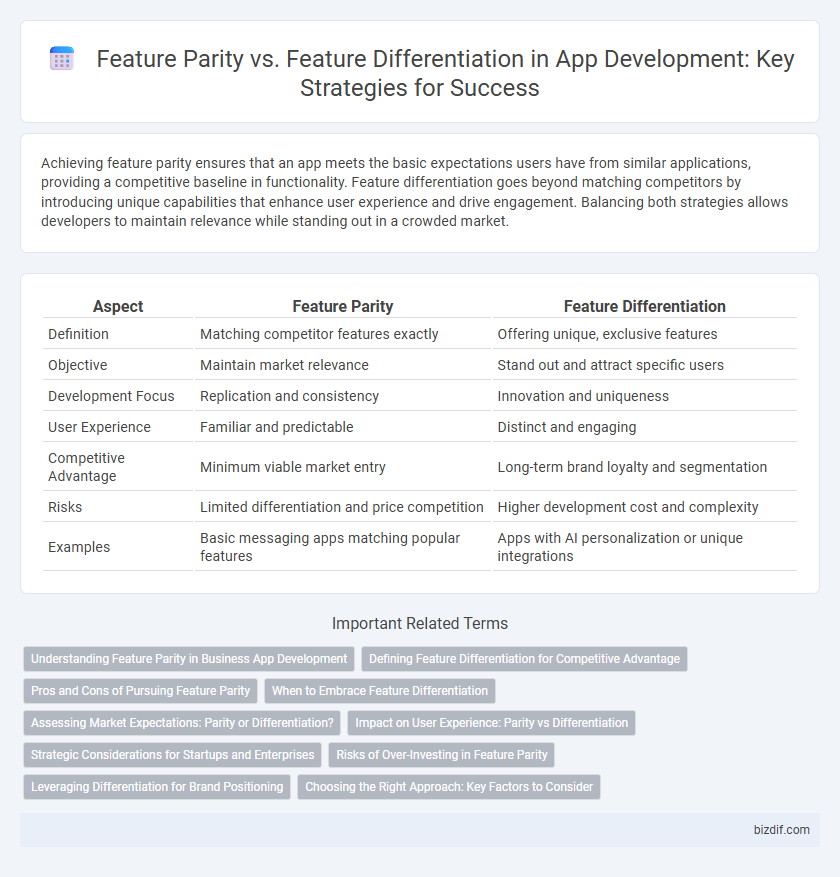Achieving feature parity ensures that an app meets the basic expectations users have from similar applications, providing a competitive baseline in functionality. Feature differentiation goes beyond matching competitors by introducing unique capabilities that enhance user experience and drive engagement. Balancing both strategies allows developers to maintain relevance while standing out in a crowded market.
Table of Comparison
| Aspect | Feature Parity | Feature Differentiation |
|---|---|---|
| Definition | Matching competitor features exactly | Offering unique, exclusive features |
| Objective | Maintain market relevance | Stand out and attract specific users |
| Development Focus | Replication and consistency | Innovation and uniqueness |
| User Experience | Familiar and predictable | Distinct and engaging |
| Competitive Advantage | Minimum viable market entry | Long-term brand loyalty and segmentation |
| Risks | Limited differentiation and price competition | Higher development cost and complexity |
| Examples | Basic messaging apps matching popular features | Apps with AI personalization or unique integrations |
Understanding Feature Parity in Business App Development
Feature parity in business app development ensures that a new or updated app matches the essential functionalities of existing solutions to maintain user expectations and market standards. Achieving feature parity minimizes the risk of alienating current users by providing a familiar experience while enabling seamless integration with existing workflows and systems. This approach supports competitive positioning by guaranteeing critical features are present before introducing unique functionalities for differentiation.
Defining Feature Differentiation for Competitive Advantage
Feature differentiation in app development involves creating unique, innovative functionalities that set an app apart from competitors, directly enhancing user experience and engagement. By focusing on exclusive features that address specific user needs or pain points, developers can capture niche markets and build brand loyalty. This strategic approach drives competitive advantage by making the app indispensable and difficult to replicate.
Pros and Cons of Pursuing Feature Parity
Pursuing feature parity in app development ensures compatibility and a consistent user experience across platforms, minimizing user confusion and streamlining support. However, it can limit innovation by discouraging unique functionalities that differentiate the app from competitors, potentially stifling competitive advantage. Maintaining feature parity often requires significant development resources to replicate features exactly, which may delay updates and reduce agility in responding to market demands.
When to Embrace Feature Differentiation
Feature differentiation becomes essential when targeting niche markets or addressing unique user needs that generic apps overlook. Prioritizing innovative or exclusive features can create competitive advantages and drive user engagement beyond standardized expectations. App developers should embrace feature differentiation during market saturation or to highlight brand identity effectively.
Assessing Market Expectations: Parity or Differentiation?
Assessing market expectations is crucial for app development, where feature parity ensures meeting baseline user demands by replicating standard functionalities found in competitors' apps. Feature differentiation targets unique capabilities that stand out, driving competitive advantage and user engagement through innovation. Balancing these approaches depends on target audience analysis, competitive landscape, and the app's strategic positioning in the market.
Impact on User Experience: Parity vs Differentiation
Feature parity ensures a consistent user experience across platforms, reducing learning curves and increasing trust by delivering familiar functionality. Feature differentiation enhances user engagement by introducing innovative, platform-specific capabilities that cater to unique needs and preferences. Balancing parity with differentiation maximizes user satisfaction by combining reliability with tailored, value-added experiences.
Strategic Considerations for Startups and Enterprises
Startups prioritize feature differentiation to capture niche markets and establish unique value propositions, leveraging limited resources to innovate quickly and stand out from competitors. Enterprises focus on feature parity to maintain consistency, meet established user expectations, and ensure seamless integration across platforms while gradually introducing differentiated features to sustain competitive advantage. Strategic decisions balance resource allocation, market positioning, and scalability requirements to align product development with business goals.
Risks of Over-Investing in Feature Parity
Over-investing in feature parity can lead to significant opportunity costs by diverting resources from innovative development and unique user experiences. This focus increases the risk of creating an indistinguishable app that fails to capture market attention or foster brand loyalty. Balancing feature parity with strategic differentiation is essential to avoid stagnation and maintain competitive advantage in app development.
Leveraging Differentiation for Brand Positioning
Leveraging feature differentiation enhances brand positioning by highlighting unique app functionalities that meet specific user needs, setting the product apart from competitors with similar offerings. Emphasizing proprietary technology, exclusive integrations, or superior user experience drives customer loyalty and attracts niche markets. Prioritizing distinctive features supports strategic marketing efforts and creates a compelling value proposition for targeted audiences.
Choosing the Right Approach: Key Factors to Consider
Choosing the right approach between feature parity and feature differentiation in app development depends on market positioning, target audience needs, and competitive analysis. Feature parity ensures compatibility and user familiarity by matching competitors' functionalities, while feature differentiation drives innovation and unique selling points that can attract niche user segments. Evaluating development resources, time-to-market, and long-term product vision helps balance stability and innovation for optimal app success.
Feature parity vs Feature differentiation Infographic

 bizdif.com
bizdif.com